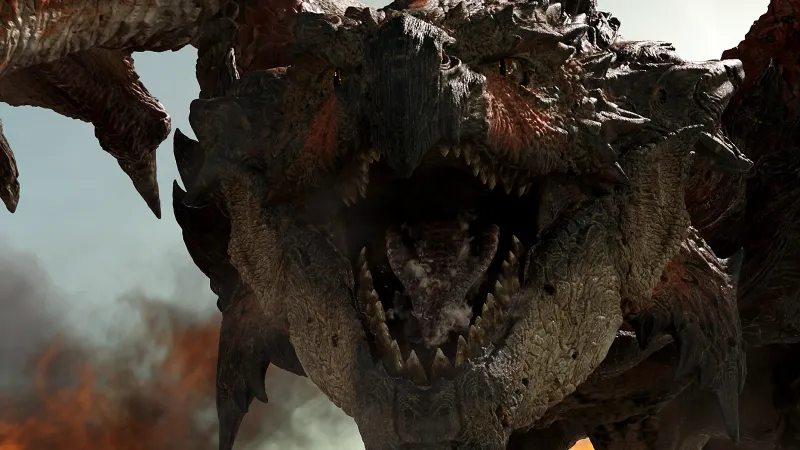
If you’re going to make a Monster Hunter movie, you really need to deliver on the monsters. In Paul W.S. Anderson’s latest film adaptation, starring Mila Jovovich and Tony Jaa, creatures run rampant, attacking everything in sight, and commanding the screen. But getting those monsters from Capcom’s long-running video game series movie ready was a lot of work, requiring hundreds of people around the world and a year-and-a-half of labor, to be exact.
To figure out how it all came together, we recently spoke with Dennis Berardi, the founder of the visual production company Mr. X and visual effects supervisor for Monster Hunter, about how he adapted Capcom’s monsters, the varying size of the creatures, and why sand is so hard to animate.
Game Informer: Before going into this project, did you play through the games to get more familiarity with the creatures or what was your relationship there?
D: I mean, I played through the games, I did a lot of research. We worked very closely with Capcom in the preparation. I got to meet the original game designers, which is a big thrill. We actually went to Japan and learned a lot about the lore and the culture. We spent some time with Ryōzō Tsujimoto and Kaname Fujioka, who are the original game designers and directors of the game, and just immersed myself. You know, I’m not an expert gamer. But I did get a copy of the game, Monster Hunter: World, at home I played it with my kids [laughs]. We had a lot of fun outfitting our cats and getting going on these quests. I mean, it’s a very immersive world. I liked finding my way through the world. Of course, my 13-year-old immediately becomes an expert and I fuddle around a little bit. But visually, which is my craft, I was inspired by it, the Wildspire Wastelands and these beautiful, epic landscapes. To me, it was just a pretty world to be in, it was very experiential in a way that you have to be pretty smart. You have to be pretty clever. You know, although I do enjoy shoot ’em up games, I felt there was something very appealing to this for me as a visual person.
GI: Sure. I mean, what are some of the specific challenges you face when adapting these monsters from this video game for a movie?
D: The biggest challenge was really to try and develop for a cinematic level, to bring out those behavioral profiles. Obviously, we took the game as inspiration, of course, that’s always our reference. We hope the fans are happy with how monsters appear on film and are rendered and act and behave. So that was our first reference. But then because it’s not a virtual environment, we’re trying to provide a photorealistic experience for the fans, we try and base our inspiration in physical anatomy, found in nature, and physical attributes that animals would would have in nature. So bringing those creatures to life, I think, is the big achievement.
We did a performance study, a motion study for each creature, where we looked at scale, how do they move, how do they plant, the weight distribution, to get a level of scale that was believable [to real people]. So, if Mila [Jovovich] or Tony [Jaa, the two leads of Monster Hunter] are doing a certain thing in a scene, you can’t have a monster moving with a different motion profile because the physics won’t match necessarily. So just stuff like that.
Scale was one of our biggest challenges. Defining the behavioral attributes for each of the monsters is a big challenge, really creating those performances. And then the photo realism of them. In some cases, we started with the Capcom models, but we had to res them up, increase the resolution for a 4K 50-foot screen – we have an IMAX release as well. These are some of the highest resolution creatures we’ve ever worked on – and I’ve worked on a lot of creature movies, including The Shape of Water [directed by Guillermo Del Toro] with the asset, the fish man, which was partially digital. These creatures are double the resolution of that creature.
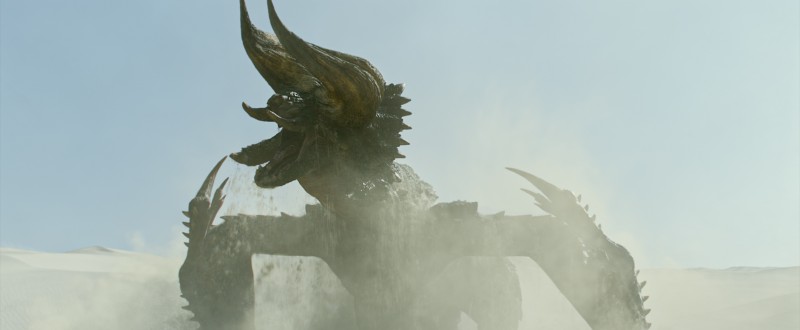
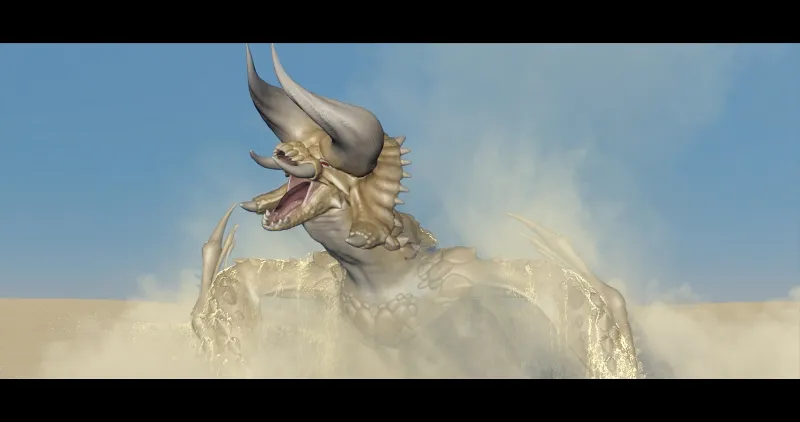

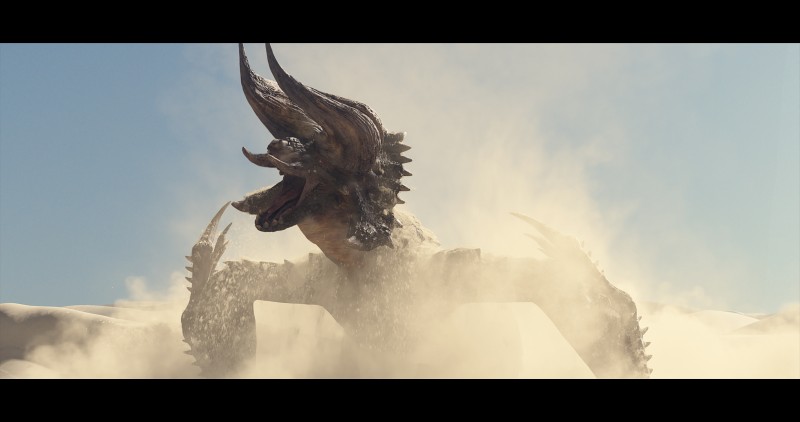
GI: What were some of the specific references you all were looking at for these monsters in nature? Like, were there specific animals?
D: For Rathalos, we were looking mostly at larger birds of prey and how they move. Everything from hawks to eagles to falcons and scaling them up. And it doesn’t always work, because Rathalos has a big, heavy center as well as these big feet, but there was reference there. Certainly for the Apceros, we looked at hippopotamus-type motion and big tortoises. They’re kind of a cross between a hippopotamus and a tortoise, if you will. Slow foot plants, big heavy creatures. For the Nerscylla we obviously took a lot of inspiration from big spiders and did a lot of motion studies on that.
For textural reference and skin, we looked at everything from alligator hides to chicken feet to hawks feet. All the textures that are rendered on those creatures began life as a texture in nature, a real texture in nature, and I think that’s why they look photo realistic. They look photo real, in my opinion. And we didn’t have anywhere to hide because a lot of the film is in broad daylight. It’s not like we’re hiding these creatures, you know?
GI: Yeah, that was actually something I noticed. Compared to a lot of monster movies, this movie is so bright. What are the challenges there, as opposed to, you know, a Godzilla movie mostly set at night?
D: We wanted to light the creatures as if they’re movie stars. So, we backlit them, we did exactly what Glen MacPhereson [director of photography] would do on set [laughs]. We would do a little ambient fill and a little bounce and usually a separate light for their eyes. We tried to really replicate that and it worked. In fact, I did photo survey everything when we were on location. And we did capture Glen’s lighting shot by shot, scene by scene, where we would do silver balls and gray balls and 360 degrees stitched HDRI images that I could then see the angle of the sun, how he placed his key and fill lights and measure the ambient levels of light as well with the tool sets that we have, and I replicated that lighting model onto the creatures
GI: Considering how monster heavy it is, how do you work with the director and cinematographer to make sure that shots are framed to facilitate all the CG that needs to go into it.
D: It’s a partnership, and we work well together. I would generally have the storyboard frames that we all agreed upon. Generally, for key sequences, I would do a 3D animatic, where I had Glenn’s lens inventory in the computer. So you know, if he had an 18 mil[limeter] lens or a 35 mil lens, or a 50, or 80, or whatever potentially that he wanted to shoot on. I would map out the scene, put a 35-mil lens on, show them what it’s like, and that would help define the spatial relationships. “This creature is 27 feet tall; we need to leave this much space for them.” And then we would stage the action as if the creature was there. I would have a person in a motion capture suit, holding a big ball for an eyeline running around, or I’d have an eyeline on a pole for Mila or Tony. Sometimes I would even on the monitor, draw out the size of the creature, just at Paul’s director’s monitor, or composite in in real time where the creature would be, just to give him a sense spatially of the frame that he’d have to frame for. But truth be told, I mean, Paul is very tech savvy. He’s a lover of visual effects. And we really only had to do that a few times before he got the feel for himself.
GI: For a movie like this, how many people are on the VFX team?
D: First of all, it was a real international production, in terms of visual [production]. Mr. X did like 95-percent of the work, which was the company I founded and am the creative director of still. So that was 450 artists across Toronto, Montreal, and Bangalore. And then we had another company, a great little company called Black Ginger, and they were based in South Africa. They did some of the onset scanning and LIDAR. So, what we did was we were on location, in Africa, we went to Namibia, and we scanned most of the locations using LIDAR scanners. And Black Ginger did that for us.


GI: Did this scale of the monsters change at all? Like if the rathalos is 30 feet tall in the game, is it 30 feet tall in the movie? Or did you have to adjust that as well?
D: We adjusted. We took some liberties. So, our version of the Rathalos, when he’s, let’s say, standing, […] not upright, but flat across like a bird of prey would do, is like 14 meters [45.9 feet] to the top point. Big boy, you know? He needed to be big because he had to take down a plane, right? Whereas Diablos is about half the size of Rathalos. The Nerscylla, because they swarm and there’s many of them, they range in scale from like one meter tall to four meters tall, to the height of their highest spine. The Apceros were, like, three meters to the top of their hump, Cephalos was smaller. So, we took some liberties on scale, because we have to lens these things in real time and we’re shooting, you know, our film format, which is widescreen. We made choices of their scale based on how we were going to film the movie.

GI: Throughout the project, what was some of the feedback you were getting from Capcom?
D: They were, boy, they were really great. I will say that Tsujimoto and Fujioka, we spent hours with them in post-production. I went down, and Paul and I made a big presentation to them. They analyzed everything, right down to like, the toenails of the of the Diablos. I’m not kidding. We did a whole anatomy presentation on them. We showed them their creatures, did a turntable where I showed their creature in 360 and then showed them our creature in 360. They had comments on color, texture, anatomy, how they moved, and their personalities. And yeah, I mean, they were very, very, very helpful, because we obviously wanted them to agree that we were, you know, being faithful to the creatures on the design side.
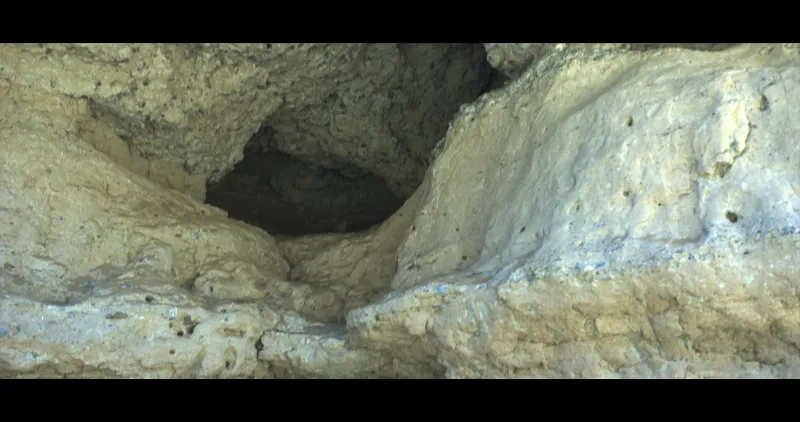
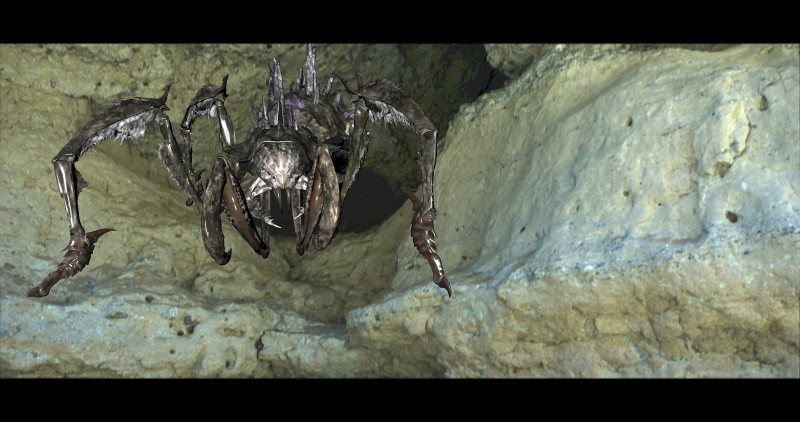
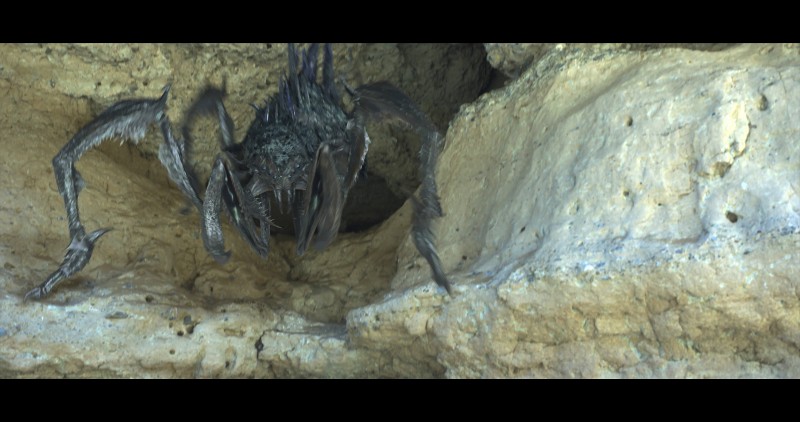
GI: One of the things I think that surprised me about this movie is just how like relentless and monster-filled the first 30 minutes are; they’re just everywhere throughout the beginning of this movie. Can you describe what the workload on this film was like? What kind of work went into just getting a single scene done when it’s so busy and so active with all these creatures?
D: Listen, hundreds and hundreds and hundreds of person weeks goes into every scene. Typically, like the Diablos shot, Black Diablos shot in the sand, where she’s chasing our military troops […] I mean, it’s a month just to get the animation sorted out with a team of dozens of people, and then it’s probably another month to light and render the shots, and then it’s another month to finalize the shot. But typically, for many sequences, it’s kind of like three or four months to get it into shape. And then there’s notes! We’ve got to see how it plays, see if it works now that it’s photo real, and then it becomes kind of like, you know, like dailies. When you shoot something on set, you do take after take after take and you kind of pick the best take […] Our process is similar. We’ll do a take, which takes three or four months, but then we might need to do another take. So, it does take a long time, which is why we did have the benefit of time. The thing that happens when you have enough time and you’re able to do multiple takes, you kind of get to live with the performance a little bit. You can come back to it, you can take a break on it, you can go work on another part of the movie and come back to it and say, “Oh, wow. What were we thinking? We were too close to it. Let’s do another take. Clearly that needs to be looking camera left. That’s wrong, let’s fix that.”
GI: This might be a weird question. But all the sand flying around the creatures and falling off them. Was that hard to animate?
D: Yeah. Just straight up, yeah, it was really hard. Whereas the creatures are hand animated, or motion captured in some cases, but mostly hand animated, or character animated or keyframe animated, the sand, you can’t animate individual grains of sand or even clumps of sand, it’s too labor intensive. It also has to react in a physically correct way. So we call that a simulation. And so what we do is we create the primary animation from the creature, or the body that’s moving through the sand, because we have the ships and everything moving to the sand as well. Create that primary animation, and then we have that primary animation drive a sand simulation, which is just a computationally heavy algorithm that spawns all these particles and has them behave and interact and react to the physical bodies and forces, including gravity and the torsional portions of the creature moving through the sand. That’s called a sand simulation.
We have so much computational difficulty there that we had to do a special deal with Microsoft to use their Azure Cloud rendering service. Because we have over 15,000 processors at Mr. X and it wasn’t nearly enough. And so, we had hundreds of thousands of processors in the Microsoft Azure Cloud for rendering those computationally difficult sand scenes. That broke new ground for us at Mr. X. At one point the Microsoft rep called me, “What the hell are you guys doing? What are you processing? Are you sending something to Nasa or something?” [I was like,] “Oh, it’s doing these sand simulations for Monster Hunter [laughs].”
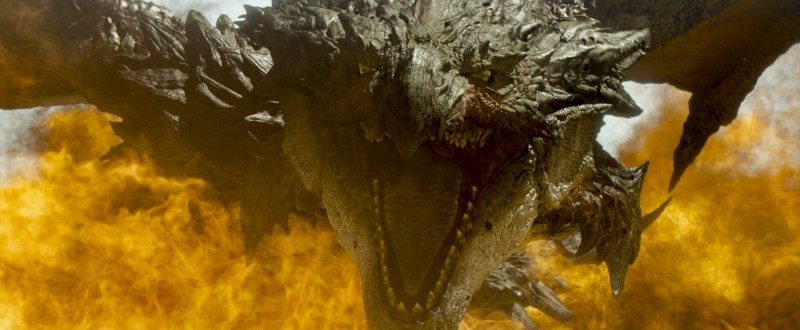
GI: Last question for you. What stands out as, like, your favorite moment or scene or thing you worked on with Monster Hunter?
D: I will say that probably the most fun that we had was with this Palico creature, you know? He’s kind of a lovable cheeky little guy. Paul gave me some autonomy on that. He let me basically cast the stand-in actor, who was this wonderful actor named Aaron Bueler, who delivered a great performance for us on the day. I put him in a gray tracking motion capture suit so Mila and Tony and Ron Perlman, they all had someone to play off. We had great fun with that. And then he became a real sort of hobby of mine. So, I really focused in on him to make sure that he was done at the level that the fans would respect. So, I’m pretty proud of Palico, for sure.
Monster Hunter is currently available to rent or purchase digitally. The movie is expected to be released on DVD and Bluray on March 2.
Source: Game Informer Creating The Iconic Beasts Of The Monster Hunter Movie

